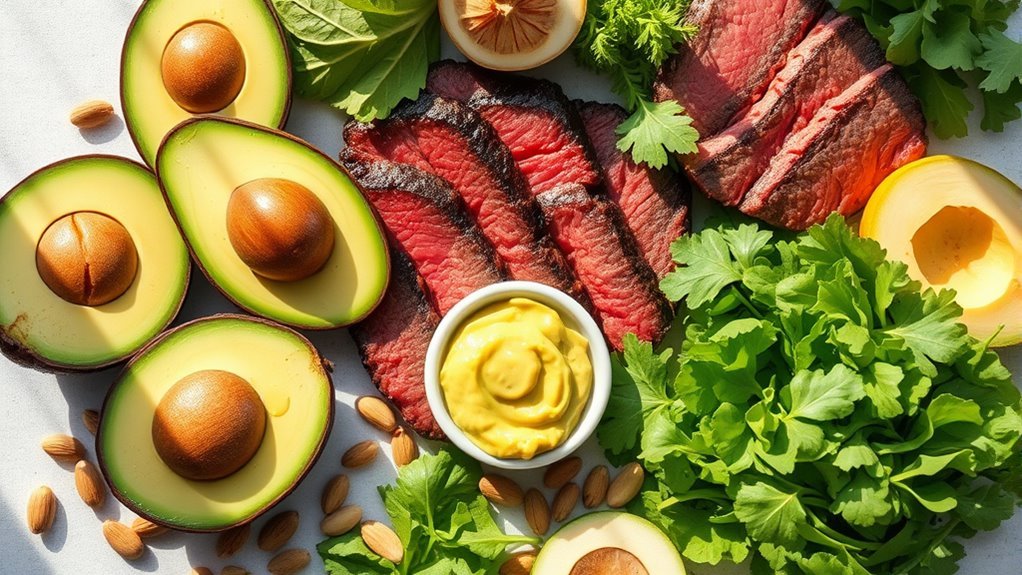A keto diet works by greatly lowering your carbohydrate intake, which prompts your body to enter ketosis. In this metabolic state, it shifts from burning glucose for energy to using fat as its primary fuel source. This process not only aids in weight loss but can also enhance your mental clarity and energy levels. Understanding how to navigate this diet, including potential challenges, can help you succeed on your keto journey. You’ll discover more about optimizing your experience.
Understanding Ketosis

When you shift your diet to a ketogenic approach, your body undergoes a significant metabolic change known as ketosis. In this state, your body becomes adept at burning fat for fuel instead of carbohydrates. Fundamentally, when carbohydrate intake is low, your liver converts fatty acids into ketones, which serve as an alternative energy source. This ketosis explanation highlights how your metabolism adapts, leading to potential weight loss and improved mental clarity. It’s crucial to recognize that while many find freedom in this lifestyle, the change can involve some challenges, like the “keto flu.” However, understanding this metabolic state can empower you to make informed choices, ultimately enhancing your overall health and well-being as you embrace the benefits of a ketogenic diet.
The Role of Carbohydrates

While ketosis emphasizes the importance of reducing carbohydrate intake, it’s essential to understand the role carbohydrates play in your overall diet. Carbs are your body’s primary source of energy, and when consumed, they’re broken down into glucose. This glucose is vital for maintaining balanced glucose levels, particularly for your brain and muscles. However, if you’re following a keto diet, lowering your carb intake shifts your body’s reliance from glucose to fat for energy. This change can help many people achieve their health goals. It’s important to recognize that not all carbs are equal; focusing on high-quality, nutrient-dense sources can enhance your diet. By understanding their role, you can navigate your choices more effectively while enjoying the freedom of a keto lifestyle.
Benefits of a Keto Diet

One of the most compelling reasons people turn to a keto diet is its potential to promote weight loss effectively. By notably reducing carbohydrate intake, your body shifts into a state of ketosis, where it burns fat for energy instead of carbs. This process can lead to rapid weight loss as stored fat is utilized. Additionally, the keto diet benefits include reduced hunger pangs, thanks to increased protein and fat intake, helping you feel full longer. Research suggests that some individuals may also experience improved mental clarity and energy levels. However, it’s essential to approach the keto diet mindfully, considering your unique health needs. This way, you can harness its weight loss potential while enjoying the freedom of a balanced lifestyle.
Common Foods in a Keto Diet
In a keto diet, you’ll primarily focus on low-carb vegetables, healthy fats, and protein-rich foods. Incorporating options like leafy greens, avocados, and fatty fish can help you maintain ketosis while ensuring proper nutrition. Understanding these common foods is essential for effectively following the keto lifestyle.
Low-Carb Vegetables
When following a keto diet, incorporating low-carb vegetables is crucial for maintaining nutritional balance while keeping carb intake in check. These keto-friendly greens, like spinach, kale, and broccoli, are low in carbohydrates but high in nutrient density. They provide valuable vitamins and minerals without compromising your carb goals.
Adding these vegetables to your meals can enhance flavor and texture while supporting overall health. For instance, zucchini makes a great substitute for pasta, and cauliflower can be transformed into rice or mashed potatoes. Being mindful of your vegetable choices not only helps you stay in ketosis but also guarantees you’re nourishing your body. So, embrace these low-carb options to enjoy the freedom of delicious, satisfying meals on your keto journey.
Healthy Fats Sources
While many people associate a keto diet with cutting carbs, it’s equally important to focus on incorporating healthy fats into your meals. Avocados are a fantastic source, offering numerous benefits like heart health support and improved digestion. Their creamy texture makes them a perfect addition to salads or smoothies. Olive oil is another staple you’ll want to include; it’s rich in monounsaturated fats and antioxidants, promoting overall wellness. Drizzling it on vegetables or using it in dressings can elevate your dishes. Don’t forget about nuts and seeds, too; they provide essential nutrients and keep you feeling satisfied. By prioritizing these healthy fats, you can enjoy flavorful meals while staying aligned with your keto goals.
Protein-Rich Foods
To achieve a well-rounded keto diet, you’ll want to focus on incorporating protein-rich foods that not only support muscle maintenance but also help keep you feeling full. Great protein sources include lean meats like chicken, beef, and pork, as well as fatty fish such as salmon and mackerel. Eggs and dairy products, like cheese and Greek yogurt, are also excellent choices. When meal planning, aim for a balance between protein and healthy fats to stay in ketosis effectively. Remember, incorporating a variety of these protein sources can keep your meals interesting and satisfying while ensuring you meet your nutritional needs. With careful selection, you can enjoy delicious meals that empower your keto lifestyle without feeling restricted.
Transitioning to a Keto Lifestyle
Starting on a keto lifestyle can feel overwhelming, especially with the myriad of dietary changes involved. To thrive, it’s essential to adopt a keto mindset, focusing on low-carb, high-fat options. Begin by researching foods that fit this framework, and don’t hesitate to embrace meal planning. This allows you to create balanced meals without the stress of last-minute decisions, ensuring you stay within your carb limits. Stock your kitchen with keto-friendly staples, like healthy fats, proteins, and low-carb veggies. Shifting gradually can ease the process, letting your body adjust to burning fat for fuel. Remember, this journey is about finding freedom in your food choices while nourishing your body effectively. Enjoy the exploration of flavors and new recipes as you adapt!
Potential Challenges and Solutions
Adapting to a keto lifestyle can come with its own set of challenges that may arise as you navigate through this dietary change. You might experience the keto flu initially, which can be managed by ensuring adequate hydration and electrolyte intake. Meal planning is essential for overcoming cravings and maintaining portion control, especially in social situations where high-carb options abound. Be mindful of potential nutrient deficiencies; consider incorporating supplements to fill gaps. Long-term adaptation may require adjusting your mindset and finding alternatives that satisfy your cravings without derailing your progress. By prioritizing hydration and being proactive in meal preparation, you can enjoy the freedom of a keto diet while overcoming these hurdles effectively.
Monitoring Your Progress
While the excitement of beginning a keto diet is palpable, effectively monitoring your progress is vital for long-term success. Progress tracking allows you to understand how your body responds to dietary changes. Weight monitoring is a key aspect, but it’s important to look beyond just the scale. Consider other metrics like energy levels and body measurements.
Here’s a simple table to help you keep track:
| Metric | Frequency |
|---|---|
| Weight | Weekly |
| Body Measurements | Bi-weekly |
| Ketone Levels | Weekly |
| Energy Levels | Daily |
| Mood and Sleep Quality | Daily |
Long-Term Sustainability of Keto
When considering the long-term sustainability of the keto diet, it is vital to recognize that maintaining such a low carbohydrate intake can be challenging for many individuals. To achieve long-term adherence, you might need to implement keto sustainability strategies that fit your lifestyle. This could include allowing for occasional carb cycling or incorporating higher-carb days to prevent burnout. Focusing on nutrient-dense foods can also help you feel satisfied and prevent cravings. It’s important to listen to your body and adjust as needed, ensuring you’re not sacrificing your overall well-being for the sake of adhering strictly to keto. Ultimately, achieving a balanced approach can help you enjoy the benefits of the keto diet while maintaining a sustainable and healthy lifestyle.


